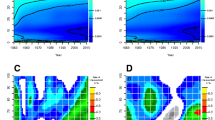Abstract
Human life expectancy has risen in most developed countries over the last century, causing the observed demographic shifts. Babel, Bomsdorf and Schmidt (forthcoming) introduce a stochastic mortality model using panel data procedures which distinguishes between a common time effect and a common age effect of mortality evolvement. Using this mortality model, the present paper provides forecasts of future life expectancy for 17 countries divided into 12 regions: Australia, Alps, Bene, Canada, England and Wales, France, Germany, Italy, Japan, Spain, Scandinavia and the United States of America. We consider (traditional) period life expectancies as well as cohort life expectancies, the latter being a more realistic approach but less common. It turns out that a continuing increase of life expectancy is expected in all considered countries. Further, we show that the probabilistic uncertainty of forecast life expectancies is different if either period life expectancies or cohort life expectancies are considered and, moreover, the uncertainty increases substantially if the error of parameter estimation is included.
Similar content being viewed by others
References
Babel, B., E. Bomsdorf and R. Schmidt. Forthcoming. Forecasting German mortality via panel data procedures.Journal of Population Economics. Published online at Online First <http://www.springerlink.com/content/1432-1475/>.
Baltagi, B.H. 2005.Econometric Analysis of Panel Data. Third Edition. Chichester: John Wiley and Sons.
Bomsdorf, E. 2002.Neue Generationensterbetafeln für die Geburtsjahrgänge 1933–2003. Cologne: Josef Eul Verlag.
Bomsdorf, E. 2004. Life expectancy in Germany until 2050.Experimental Gerontology 39(2): 159–163.
Bomsdorf, E. and M. Trimborn. 1992. Sterbetafel 2000. Modellrechnung der Sterbetafel.Zeitschrift für die gesamte Versicherungswissenschaft 81: 457–485.
Booth, H. 2006. Demographic forecasting: 1980–2005 in review.International Journal of Forecasting 22(3): 547–581.
Booth, H., R. Hyndman, L. Tickle and P. De Jong. 2006. Lee-Carter mortality forecasting: a multi-country comparison of variants and extensions.Demographic Research 15(9): 289–310.
Booth, H., J. Maindonald and L. Smith. 2002. Applying Lee-Carter under conditions of variable mortality decline.Population Studies 56(3): 325–336.
Booth, H. and L. Tickle. 2004. Beyond three score years and ten: prospects for longevity in Australia.People and Place 12(1): 15–27.
Booth, H., L. Tickle and L. Smith. 2005. Evaluation of the variants of the Lee-Carter method of forecasting mortality: a multi-country comparison.New Zealand Population Review 31(1): 13–34.
Canudas-Romo, V. and R. Schoen. 2005. Age-specific contributions to changes in the period and cohort life expectancy.Demographic Research 13(3): 63–82.
Deutsche Aktuarvereinigung. 2004.Herleitung der DAV-Sterbetafel 2004 R für Rentenversicherungen. Internal Report.
Goldstein, J.R. and K.W. Wachter. 2006 Relationships between period and cohort life expectancy: gaps and lags.Population Studies 60(3): 257–269.
Lee, R.D. 2000. The Lee-Carter method for forecasting mortality, with various extensions and applications.North American Actuarial Journal 4(1): 80–93.
Lee, R.D. and L.R. Carter. 1992. Modeling and forecasting US mortality.Journal of the American Statistical Association 87(419): 659–671.
Li, S.H. and W.S. Chan. 2005. Outlier analysis and mortality forecasting: the United Kingdom and Scandinavian countries.Scandinavian Actuarial Journal 3: 187–211.
Oeppen, J. and J.W. Vaupel. 2002. Broken limits to life expectancy.Science 296(5570): 1029–1031.
Pitacco, E. 2004. Survival models in a dynamic context: a survey.Insurance: Mathematics and Economics 35(2): 279–298.
Riphahn, R.T. and K.F. Zimmermann. 2000. The mortality crisis in East Germany. Pp. 227–252 in G.A. Cornia and R. Paniccià (eds),The Mortality Crisis in Transitional Economies. Oxford: Oxford University Press.
Rogers, L.C.G. and D. Williams. 1994.Diffusions, Markov Processes, and Martingales, Volume 1:Foundations. 2nd Edition. Chichester: John Wiley and Sons.
Statistisches Bundesamt. 2003.Bevölkerung Deutschlands bis 2050. Wiesbaden.
Thatcher, A.R., V. Kannisto and J.W. Vaupel. 1998. The force of mortality at ages 80 to 120.Odense Monographs on Population Aging No. 5. Odense: Odense University Press.
Tuljapurkar, S. and C. Boe. 1999. Mortality change and forecasting: how much and how little do we know?North American Actuarial Journal 2(4): 13–47.
Tuljapurkar, S., N. Li and C. Boe. 2000. A universal pattern of mortality decline in the G7 countries.Nature 405(6788):789–792.
Author information
Authors and Affiliations
Corresponding author
Rights and permissions
About this article
Cite this article
Babel, B., Bomsdorf, E. & Schmidt, R. Future life expectancy in Australia, Europe, Japan and North America. Journal of Population Research 24, 119–131 (2007). https://doi.org/10.1007/BF03031881
Issue Date:
DOI: https://doi.org/10.1007/BF03031881




